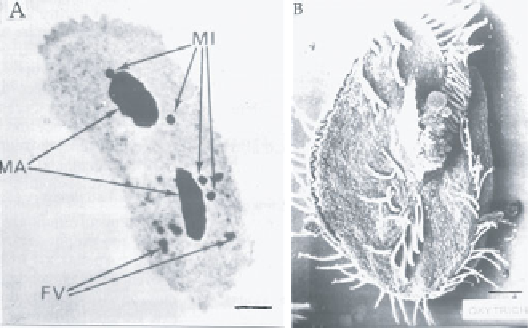Information Technology Reference
In-Depth Information
INTRODUCTION
The ciliate strategy rests on the evolution of nuclear dimorphism: the inclusion
both of a germline nucleus (micronucleus) and a somatic nucleus (macronu-
cleus) in the same cell (Figure 9.1; for a general review, see Prescott [6, 7]).
Like the example in Figure 9.1, most stichotrich species contain two or more
micronuclei and two or more macronuclei per cell.
The multiple micronuclei are genetically identical to each other, and the
multiple macronuclei are genetically identical; these multiplicities of nuclei
have no bearing on the issues addressed in this chapter. The micronucleus is
used only in cell mating, and its genes are silent. Hence, micronuclear genes
do not support the maintenance, growth, or division of the cell. The genes in
the macronucleus are actively transcribed into the mRNA molecules required
to maintain cell structure and function.
In spite of their vastly different functions, the micronucleus and macronu-
cleus are closely related, a relationship that is evident in the sexual phase of the
ciliate life cycle. Stichotrich ciliates make a living by ingesting other organisms,
such as other ciliates, unicellular alga, and bacteria. When such food organisms
are available, stichotrich ciliates proliferate rapidly, typically undergoing cell
division every 6-8 h. When starved for food, ciliates may enter a sexual phase,
in which they mate in pairs. Mating begins with the joining of two cells by a
cytoplasmic channel (Figure 9.2).
Cell joining is quickly followed by meiosis of the micronuclei in each cell,
in which four haploid micronuclei are formed from each diploid micronucleus
Figure 9.1
(a) A light microscope photograph of a stichotrich (
Sterkiella nova
) that
has been stained to show its two macronuclei and four micronuclei. (b) A scanning
electron micrograph of
Sterkiella nova
. Bars
=
10
µ
m. Courtesy of Dr. K.G. Murti.

